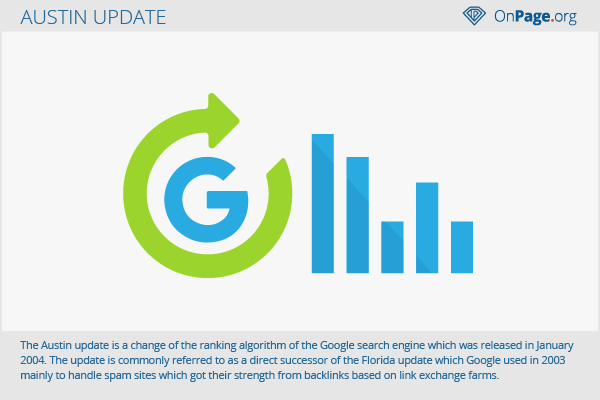Austin Update
The Austin update is a change of the ranking algorithm of the Google search engine which was released in January 2004. The update is commonly referred to as a direct successor of the Florida update which Google used in 2003 mainly to handle spam sites which got their strength from backlinks based on link exchange farms.
The Austin update resulted in a lot of criticism among webmasters because after it was rolled out many sites that were not involved in any of the manipulative measures that the update addressed were affected by ranking losses. The Brandy update is considered a correction of the Austin update by Google.
Background
After the Google search engine was launched at the end of the 1990s and became more and more successful, the number of websites that were successful in the SERPs through webspam actions increased proportionately. Webspam threatened the business model that Google operated with its AdWords program because if the SERP contained inferior results, users may conclude from this that the ads next to them are also inferior.
At that time, Google had not yet reached the market share it enjoys worldwide today. Therefore, it was important to react quickly so that advertisers and users did not lose confidence in the search engine. Google wanted to curb spam measures with a new update of the algorithm. This was first sought via the Florida update in 2003, which the Austin update was meant to perfect.
Before the update, ranking was done according to criteria such as keyword density, keyword position, meta tags, relevant texts, or internal links. Website operators could control these criteria themselves. With keyword-focused interplay between these criteria and massive quantitative link building, a website’s ranking could be easily improved. Finally, a new calculation factor was introduced with the Austin update, which gave more weight to links from topic-related pages. To date, Google performs regular updates to keep the quality of the search results high.
Problems and impacts
After the Austin update, many spam sites were removed from the Google index. At the same time, websites which did not contain spam were removed from the index as well. Many websites lost their high ranking or disappeared completely from the index unjustly as “collateral damage.” Furthermore, websites such as Amazon or eBay frequently appeared as top hits in the search results since they had a correspondingly large number of links that were directed to them.
The Austin update had serious consequences for many webmasters. Websites that have been used to generate revenue or online stores had massive financial losses due to the traffic loss after the algorithm change. The effects can almost be compared to the consequences of the Panda and the Penguin updates. The harsh criticism of the web community eventually resulted in Google readjusting the algorithm with the Brandy update in February of 2004.

